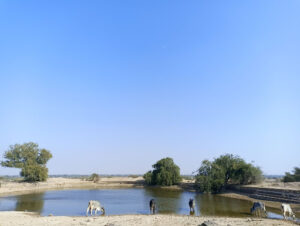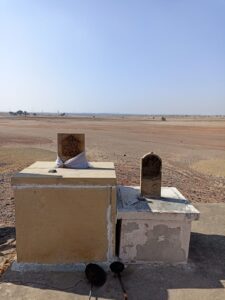
The limited possibility of agriculture within the harsh landscape of Rajasthan had compelled the people to adopt varied strategies of subsistence, one of which was aligned with the activity of animal husbandry. Thus, to sustain the livestock from the meagre vegetation that was often wild in nature, orans, as secured wildernesses, became safe harbours that thrived the stock of the local community, supporting all livelihoods within it. Traced from the mentions in the Rig Veda, the word ‘Oran’ is etymologically derived from the Vedic goddess ‘Aranyani’ alluded to in the 10th Mandala and being perceived as the elusive goddess of forests and the wild animals that dwell within them.
Beginning as communal lands that were being donated by each member of the community from his dominion, the orans were later elevated towards sanctity as they became associated with varied folk deities i.e. Jhujhār’s (ancestral heroes), satis, gods and goddesses, that resided within the boundary of the grove and punished those who dared to raze any natural life living within it. This association thus reinstated the space’s sacredness amongst the villagers’ consciousness to protect and conserve the land for communal and ritual use. Obligations were also enacted through sacred laws that governed the actions of the community towards the maintenance of these sacred groves.

Trees that are rooted inside the Oran such as the bordi (Ziziphus nummularia), babool (Vachellia nilotica), jal (Salvadora oleoides), and khejri (Prosopis cineraria) are prohibited from cutting for fear that trees that are conceived dear to the divinity if cut would bring death, disease, paralysis and other predicaments to the offender. The recurring stories of ‘Nathmal’ are also recited by the village folk, who once took wood from the bordi tree in the thought of making a pālanā (cradle) for their newborn child. Growing greedy, he borrowed some leaves from the tree to shelter the shed constructed for his buffaloes. Cursed by sinning in cutting the tree dear to the folk goddess, his newborn son, wife, and later buffaloes died an unfortunate death. Stories such as these are some of the vestiges of local manoeuvrings that embody the communal psyche in protecting these spaces and are often recited to the new visitors as a warning from the curse that would bind them if they didn’t heed the laws that govern the sacred grove.
Thus employment of oran is only permitted for grazing of the livestock with a caution that no fodder should be taken out of the land. Dried branches or twigs that have fallen naturally could be used as fuelwood by the village community for their daily use. As the land is deemed to be a sacred space, the inheritance of them to anyone except the temple authority is being maintained and thus no settlement could be established within it. Even if the villagers are utilising some portion of the Oran for agricultural use, a part of the produce from the harvest is to be donated to the temple establishment along with a feast (Bisont) to unmarried girls from the village that is offered in the name of the presiding deity.

Till 1949, as the princely states maintained their autonomy with all the powers of authority upheld by the sovereigns of the princely states in Rajasthan, the land considered as an ‘Oran’ was recorded in the official royal registry where no taxes were levied on them as no revenue was generated from these lands and were deemed as community spaces, used and maintained by the community themselves. However, once the princely states were fully integrated with the Indian Union, the official criteria, which were based on an earlier British model, didn’t have any specified category to recognise these unconventional communal lands and were therefore entitled within the category as ‘wastelands’. In the 70’s-’80s, some active citizens along with the temple’s trustees rectified the records and integrated the land as belonging to the temple establishment. Others however remained unaware of this situation with many of their communal lands being handed out openly to the foreign companies, who established energy plants inside them. The popular demand of the local community thus seeks a new category to classify these lands that guarantee their place in the official land registry with governing rights over its utilisation being handed over to the community as earlier committed under the imperial rule.
An atmosphere of mistrust between the settled community and the invasive multinational companies still persists, arising from the violation of the sacred principles set by the villagers and instances of extracting natural resources for an influx of profit attained by the company itself. While employment opportunities are also being provided to the village folk, however, temporal nature of the assigned jobs and relatively low rate of employment provision renders the scheme to a negligible portion of the society where subsistence is entirely dependent on pastoral activities that thrive on Oran. The significance of the Oran is also accentuated by the fact that these places are home to many of the medicinal plants and extinct species of plantations that are commonly employed for sustenance by the local community. However, as the march of the modernised companies advances in the parched lands of the desert, the ancient sacred lands as the solace of the village community are thus prone to cessation.

